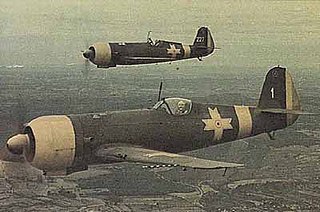
The IAR 80 was a Romanian World War II low-wing monoplane, all-metal monocoque fighter and ground-attack aircraft. When it first flew, in 1939, it was comparable to contemporary designs being deployed by the airforces of the most advanced military powers such as the Hawker Hurricane and Bf 109E. Production problems and lack of available armament delayed entry of the IAR 80 into service until 1941. It remained in frontline use until May 1945.

The Soko J-22 Orao is a Yugoslavian twin-engined, subsonic ground-attack and aerial reconnaissance aircraft. It was developed and built in collaboration by SOKO in Yugoslavia and by Avioane Craiova in neighbouring Romania, being known in the latter as the IAR-93 Vultur.

The Avioane Craiova IAR-93 Vultur (Eagle) is a twinjet, subsonic, close support, ground attack and tactical reconnaissance aircraft with secondary capability as low level interceptor. Built as single-seat main attack version or combat capable two-seat version for advanced flying and weapon training, it was developed in 1970s by Romania and Yugoslavia to become more independent from Soviet equipment. The Romanian aircraft were built by I.R.Av. Craiova as IAR-93, and its Yugoslav counterpart by Soko as the Soko J-22 Orao. For Romania, the IAR-93 was intended to replace MiG-15s and MiG-17s in the fighter-bomber role.

The Romanian Air Force (RoAF) (Romanian: Forțele Aeriene Române) is the air force branch of the Romanian Armed Forces. It has an air force headquarters, an operational command, five airbases and an air defense brigade. Reserve forces include one air base and three airfields.

The IAR 99Șoim (Hawk) is an advanced trainer and light attack aircraft capable of performing close air support and reconnaissance missions. The IAR 99 replaced the Aero L-29 Delfin and Aero L-39 Albatros as the jet trainer of the Romanian Air Force. The aircraft is of semi-monocoque design, with tapered wings and a swept-back tail unit. A large blade-type antenna installed beneath the nose on the port side of the fuselage gives the IAR 99 trainer a distinctive appearance.
Craiova International Airport is located in the south-western part of Romania, 7 km (4.3 mi) east of Craiova municipality, one of Romania's largest cities. The airport area is the headquarters of Avioane Craiova, the company which built the Romanian IAR-93 and IAR-99 aircraft.

The Romanian Air Force 71st Air Base is located in the commune Luna near the city of Câmpia Turzii, in Cluj County. The 71st Air Base was founded on 1 June 2002 from the previous 71st Fighter and Bombardment Base, according to the Romanian Armed Forces reorganization program. It is named after Emanoil Ionescu, a general who commanded the 1st Air Corps of the Royal Romanian Air Force during World War II.

The Romanian Air Force 86th Air Base "Lieutenant Aviator Gheorghe Mociorniță" is located in commune Borcea, Călărași County near the town of Fetești. It is currently the home of the 53rd Fighter Squadron.

The Romanian Air Force 95th Air Base "Captain Alexandru Șerbănescu" is an air force base adjacent to George Enescu International Airport, Romania, south of Bacău, Bacău County.

The Romanian Air Force 57th Air Base "Mihail Kogălniceanu" is an air base located near Constanța, at the Mihail Kogălniceanu International Airport. It is currently home to the 572nd Helicopter Squadron. The current base commander is Comandor Nicolae Crețu, succeeding Comandor Adrian Popescu.

The Romanian Air Force 93rd Air Base, also known as Giarmata Air Base, was an air base located in the commune Giarmata, near Timișoara, at the Traian Vuia International Airport. The base was disbanded in August 2004 due to the Romanian Armed Forces reorganisation program and the retirement of the MiG-23s which were based here.
Avioane Craiova S.A. is an aeronautical company based in Ghercești, near Craiova, Romania. It has been involved in the manufacture of various military aircraft, including the IAR-93 Vultur ground-attack fighter, the IAR-99 advanced jet trainer/light attack aircraft, and the cancelled IAR-95 Spey fighter.
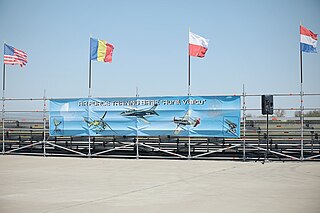
The Air Force Application School "Aurel Vlaicu", also known as Boboc Air Base, is the Romanian Air Force Application School based at Boboc, Buzău County. Originally located at the Boboc airfield starting from 1939, the school was re-established as the "Aurel Vlaicu" Aviation Officers School in 1953, and moved back to Boboc in 1958. Since August 2003, as a result of the air force transformation and re-sizing, the Air Force Application School is the main applicational facility for the three main air force branches: air force, surface-to-air missiles, and radiolocation.
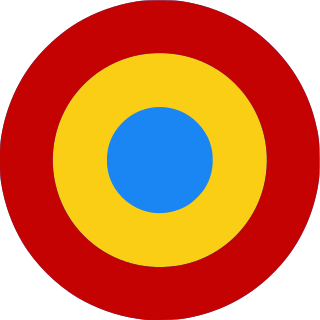
The Romanian Air Corps or Aviation Corps (RAC) was the air arm of the Romanian army until the formation of the Romanian Air Force. It was established on 1 April 1913 as the Military Aeronautics Service and subordinated to the Engineer Inspectorate, being organized in two branches – the aviation and the balloon branch. On 23 August 1915, the RAC was formed as an independent military arm and operated until 1 January 1924 when it became an equal to the Army and Navy, being redesignated as the Royal Romanian Air Force.

The Army of the Socialist Republic of Romania, known as the Army of the Romanian People's Republic, until 1965 was the army of the Socialist Republic of Romania from 1947 to 1989. Following the Romanian Revolution in 1989 it was renamed into the Romanian Armed Forces. It consisted of the Ground Forces, the Navy and the Air Force.
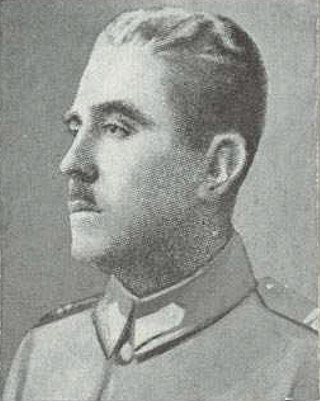
Ștefan Protopopescu was a Romanian officer and aviation pioneer, he held the no. 1 pilot license in Romania, being the first licensed pilot in Romania and the first pilot of the Romanian Army.

The 53rd Fighter Squadron "Warhawks" is a squadron of the Romanian Air Force, first formed on 1 June 1940, then reactivated on 29 September 2016. The squadron currently operates the F-16AM/BM fighter aircraft.
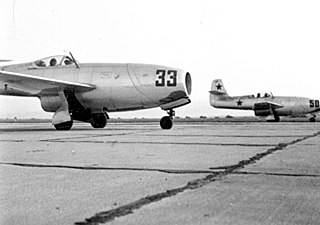
The Ianca Air Base, or the 49th Air Base, was a Romanian Air Force base located in the town of Ianca in the Brăila County. It was active from 1941 to 2001 and was the first unit equipped with jet fighters in Romania.


















